1. The width of retro-reflective markings should select from the following values: 50mm, 75mm and 100mm. In event that the retro-reflective markings with width of 50mm can not be affixed to certain types of vehicles, two retro-reflective markings with width of 25mm can be affixed to those vehicles in parallel.
2. For N1, N2 vehicles, full trailers and semi-trailers, the retro-reflective markings installed can reflect the width of the rear vehicle. The minimum height from the ground of retro-reflective markings for rear vehicle body is 380mm. The total area of rear retro-reflective markings and rear reflectors should not be less than 0.2m2.
3. Any vehicle serial and trucks with length of over 10m should be installed retro-reflective markings for vehicle body. Retro-reflective markings on side faces of the vehicle body allow interrupts, but each successive length should be larger than 300mm and include at least one red unit and one white unit of the retro-reflective markings for vehicle body. The total length of retro-reflective markings on the side faces should not be less than 50% of the vehicle length and the total area of retro-reflective markings and reflectors should not be less than 0.2m2.
4. The total area of retro-reflective markings affixed to each vehicle should be less than 2m2.
5. The retro-reflective markings affixed to vehicle body shall not be blocked and the affixed retro-reflective markings shall not affect original properties of lighting and signal devices of the vehicles.
6. If the vehicles have protective equipments, retro-reflective markings of carriage can be pasted to the protective equipments.
The retro-reflective markings of rear vehicle body shall begin with white unit and end with white unit. The retro-reflective markings of side face of vehicle body shall begin with red unit and the last unit (close to the rear of the vehicles) shall be white unit. The affixed retro-reflective markings shall not affect the properties of lighting and signal devices of the vehicles (stipulated in this standard). After the retro-reflective markings are affixed to vehicle body, people can not drill holes and slot on the retro-reflective markings. When the retro-reflective markings can not be pasted directly on the vehicle body, users should paste retro-reflective markings on the liner plate which has some stiffness, strength and anti-aging and then paste or rivet this liner plate to the vehicle body. The minimum height from the ground of Retro-reflective markings for the vehicle body is 380mm.
First, retro-retro-reflective markings at the rear part of vehicle body should reflect the width and height of the rear part of the vehicle; retro-reflective markings pasted horizontally reflect the width of the rear part of the vehicle and the retro-reflective markings pasted on two vertical edges reflect the height of the rear part of the vehicle. The rear corner intersection part of the cargo compartment should be white units. If the rear cargo compartment structures of three-wheeled vehicles, low-speed cargo vehicles, mini goods vehicles and part of the light goods vehicles can not meet the requirements of white unit intersection, white and red unit intersection is also acceptable but the upper part of the retro-reflective markings pasted vertically should be white unit. The retro-reflective markings for vehicle body of rear part of vans and van trailers should reflect the carriage profile.
Second, different grades of retro-reflective markings for the vehicle body should not be affixed to the same rear part of the vehicle. When Grade One retro-reflective markings material has been adopted, the total area of retro-reflective markings and rear reflectors should not be less than 0.1m2. When Grade Two retro-reflective markings material has been adopted, the total area of retro-reflective markings and rear reflectors should not be less than 0.2m2.
Finally, the retro-reflective markings for the rear part of the vehicle should be pasted continuously. If the continuous pasting is not possible, the interrupted pasting is also acceptable but each continuous segment length should not be less than 300mm and include at least one red unit and one white unit, and pasting interruption should not larger than 100mm. Under special circumstances, to paste red units and white units separately is allowed but the red units and white units should be separated. Each continuous segment length should not be less than 150mm and pasting interval should not be larger than 100mm. If you can not paste the retro-reflective markings on the two side edges of rear part of the vehicle vertically, you can paste the retro-reflective markings along vertical lines with distance 50mm to side edge of the rear vehicle part; the upper end of the retro-reflective markings should be as close to the upper edge of the rear part of the vehicle as possible.
Retro-reflective markings on the sides of the vehicle body allow interrupts but the total length (excluding the interval parts) should not be less than 50% of the vehicle length; each continuous segment length should not be less than 300mm and should include at least one white unit and one red unit respectively. The pasting interval of the Class Two retro-reflective marking material should not exceed 150mm, the pasting interval of the Class One retro-reflective markings material should not exceed 300mm and pasting should be as evenly distributed longitudinally as possible. Under special circumstances, to paste red units and white units separately is allowed but the red units and white units should be separated. Each continuous segment length should not be less than 150mm. The pasting interval of the Class Two retro-reflective marking material should not exceed 150mm; the pasting interval of the Class One retro-reflective marking material should not exceed 300mm.
For three-wheeled vehicles, the length of retro-reflective markings of vehicle body sides should not be less than 1.2m. If the carriage length is less than 50% of total length of cargo truck, the carriage length should be deemed as the length of retro-reflective markings. In event that the side structure of the vehicle body doesn’t have continuous surface, such as cement mixers, special operations vehicles, the total pasting length should not be less than 30% of total vehicle length. The retro-reflective markings on the sides of the vans and van trailers should be able to reflect the outline of the carriage.

Typical Pasting Example on the Sides of Three-wheeled Vehicles
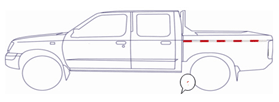
Typical Pasting Example of the Sides of Cargo Vehicle (Carriage length less than 50% of the total vehicle length)
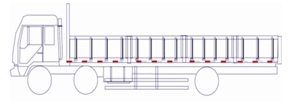
Note: Except three-wheeled vehicles, the van whose carriage length is less than 50% of the total length of the van, and cement mixers and special operations vehicles, whose side vehicle body structure doesn’t have a continuous surface, but the retro-reflective markings length on the sides of other goods wagons and trailers should not be less than 50% of the total length of goods wagon.

Typical Pasting Example on the Rear Part of Three-wheeled Vehicles, Low-speed Goods Wagon, Column Plate Style Goods Wagon and Column Plate Style Semi-trailers
3. Typical Pasting Example of Low-Speed Van, General Van and Van Semi-trailer

Retro-reflective Markings Pasting Diagram of Low-Speed Van, General Van and Van Semi-trailer
Note: On the sides of vans, paste the retro-reflective sheeting along the carriage bottom edge and at upper two side corners, two 150mm-long white units for each corner have formed “Inverted L” in the horizontal and vertical directions. In the rear part of the vans, the retro-reflective sheeting has drawn outline of the rear part of vans. In the four corners in the rear part, four corners should be the connections of white units. Due to hinges, locks, etc, when the reflective film can not be pasted continuously, intermittent paste is allowed. Figure b) is a typical pasting example of the Class Two reflective film for the vehicle body; when the Class One retro-reflective sheeting is used, four corners of the rear part of the van should be outlined by white retro-reflective units and other parts shall adopt the intermittent paste, but each continuous segment length should not be less than 300mm including at least one white unit and one red unit.
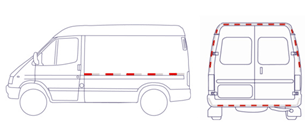
Typical Pasting Example of Enclosed Goods wagon
5. Typical Pasting Example for Storage Truck and Storage Semi-trailer
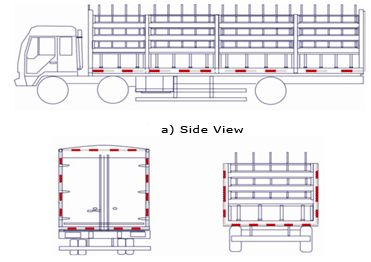
Note: In the rear part of the truck, the retro-reflective markings have drawn outline of the rear part of the truck. In the four corners in the rear part, edges and corners should be the connected by the white retro-reflective markings units. Due to hinges, locks, etc, when the retro-reflective markings can not be pasted continuously, the intermittent paste is allowed.No. b of Figure 21) is a typical pasting example of the Grade Two retro-reflective markings for the vehicle body; when the Grade One retro-reflective markings are used, four corners of the rear part of the truck should be outlined by white retro-reflective markings units and other parts shall adopt the intermittent paste, but each continuous segment length should not be less than 300mm including at least one white unit and one red unit. The total pasted areas should not be less than 0.1m2. Figure b) is the typical pasting example for Class Two retro-reflective markings materials for the vehicle body. While using the Class One retro-reflective markings materials, you shall choose intermittent paste. In vertical direction, the retro-reflective markings are pasted to the top and bottom of the truck; in the horizontal direction, retro-reflective markings should be pasted to far left, far right and middle part. Each continuous segment length should not be less 300mm and should include at one red retro-reflective markings unit and one white retro-reflective markings unit. The pasted areas should not be less than 0.1m2. .
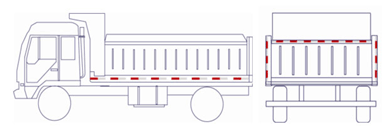
Typical Pasting Example of Low-speed Dump Truck and Dump Truck
Note: The retro-reflective markings should be pasted to the top part of railing panel, lower part of the railing panel or lower protective equipments in the rear of the low-speed dump truck and dump truck. Figure b) is the typical pasting example for Grade Two retro-reflective markings materials for the vehicle body. While using the Class One retro-reflective markings materials, on condition that the width and height of rear part of truck are ensure, you shall choose intermittent paste. In vertical direction, the retro-reflective markings are pasted to the top and bottom of the truck; in the horizontal direction, retro-reflective markings should be pasted to far left, far right and middle part. Each continuous segment length should not be less 300mm and should include at one red retro-reflective markings unit and one white retro-reflective markings unit. The pasted areas should not be less than 0.1m2.

a) Side View b) Rear View
Typical Pasting Example of Low-speed Dump Truck and Dump Truck
Note: for lateral side of flatbed truck, the retro-reflective markings should be pasted to the continuous surface of bottom edge horizontally. Figure b) is a typical pasting example for Class Two retro-reflective markings. If the retro-reflective markings can not be pasted to the bottom flatbed, two rows of retro-reflective markings should be affixed to the protective equipments in parallel and pasting areas should not be less than 0.2m2. When the Class One retro-reflective marking materials are used for the rear part of the flat truck, you can paste the retro-reflective markings materials continuously on lower or back protective equipments and pasting areas should not be less than 0.1m2.
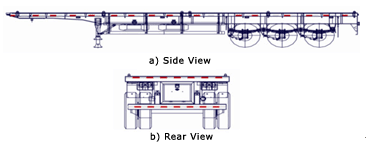
Note: Retro-reflective markings should be pasted to the lateral truck frame horizontally. Due to different truck structures the pasted retro-reflective markings may not be in the same horizontal plane. If there are lower protective equipments in the rear part of the flatbed semi-trailer and container semi-trailer, the retro-reflective markings should be pasted to the lower protective equipments The Class Two retro-reflective markings should be pasted to the rear part of the flatbed and lower part of the rear of truck continuously. If Class One retro-reflective markings are used, the intermittent paste is applicable, but each continuous segment length should not be less than 300mm and at least include one white retro-reflective markings unit and one red retro-reflective markings unit. The total pasted areas should not be less than 0.12. When the container semi-trailer is used to load a container, the retro-reflective markings should be pasted to the container. Regarding pasting style, please refer to the above figure.
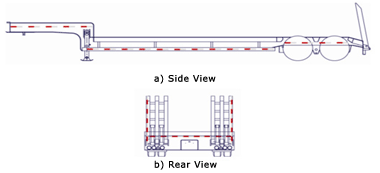
Note: The retro-reflective markings should be pasted to lateral side of the truck along the smooth & continuous surface and the intermittent paste is applicable. Due to different truck structures the pasted retro-reflective markings may not be in the same horizontal plane. The Class Two retro-reflective markings should be pasted to the rear part of the flatbed and lower part of the rear of the flatbed semi-trailer continuously. If Class One retro-reflective markings are used, the intermittent paste is applicable, but each continuous segment length should not be less than 300mm and at least include one white retro-reflective markings unit and one red retro-reflective markings unit. The total pasted areas should not be less than 0.1m 2.As the flatbed semi-trailer has a ladder in the rear part, the retro-reflective markings should be pasted to the outmost ladder frame, at least to the top part, medium part and lowest part of the ladder. Each continuous segment length should not be less than 300mm and including one red retro-reflective markings unit and one white retro-reflective markings unit.
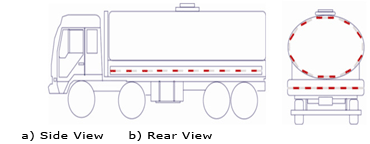
Note: for tank truck and tank semi-trailer, the retro-reflective markings should be pasted to the lateral truck frame or the middle part of tank horizontally to reflect the length of the tank. For the irregular tank semi-trailer, the retro-reflective markings should be pasted to the middle part of the side face to reflect the length of the tank. In the rear part of the tank truck, retro-reflective markings are used to draw the outline of the tank. The quantity actually used of Class Two Reflective materials should twice as many as the Class One retro-reflective markings materials

Note: For the side face of the tank truck, the retro-reflective markings should be pasted along the frame part of the truck horizontally to reflect the length of truck frame. Paste “L” and “Inversed L” shape retro-reflective markings to the upper part and lower part of the tank and keep the distance between “L” / “Inversed L” shape retro-reflective markings and the orange reflective band is 100-300mm; the distance of retro-reflective markings between retro-reflective markings and two ends of the tank should be less than 30mm. For the rear part the tank truck, we has adopted white retro-reflective markings for vehicle body to draw the outline of tank truck: the interval for Class Two retro-reflective markings materials should be less than 50mm and the interval for Class One retro-reflective markings materials should be less than 100mm.
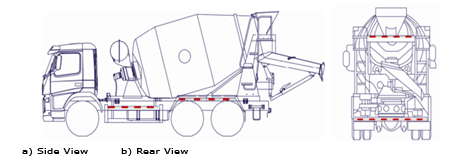
Note: The retro-reflective markings for side faces of the cement mixer should be pasted continuously on any possible places (e.g. lateral protective equipments) and the total length of pasted retro-reflective markings can be less than 50% of the total length of the vehicle, but the total length of pasted retro-reflective markings should not be less than 30% of the whole length of the vehicle and the intervals shall not be unrestricted. For the rear part of the cement mixer, the retro-reflective markings should be pasted to any continuous surface which can reflect the width and height of the vehicle rear part, such as Lower guards, metal fenders and other fixed structural parts.
The retro-reflective markings pasting should be done according to the above-mentioned basic pasting requirements, but part of special operation vehicles except driving cab have not any continuous surface and can not meet the requirements. Under these circumstances, please to choose the continuous surface in the rear part of the vehicle to paste the retro-reflective markings, such as lower guards, metal fender and other fixed structural parts; the retro-reflective markings for sides of the special operation vehicle should be pasted continuously (e.g. lateral protective equipments), the total length of pasted retro-reflective markings can be less than 50% of the total length of the vehicle but should not be less than 30% and the intervals shall not be unrestricted.
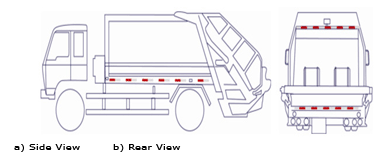
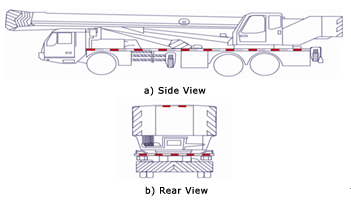
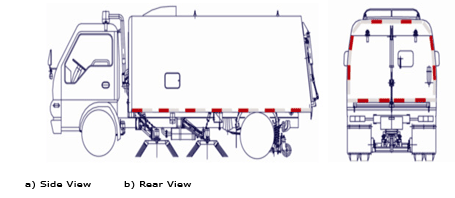
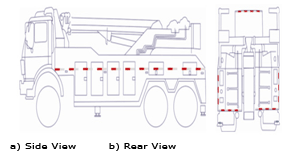
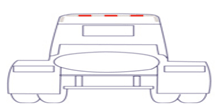
Note: We don’t need to paste retro-reflective markings on the sides of the semi-trailer tractor but we should paste retro-reflective markings on the back of driving cab. If we use Class Two retro-reflective sheeting for the vehicle body, two rows of retro-reflective sheeting should be pasted continuously on the back of the driving cab horizontally; two 150mm-long white units should be pasted vertically on each side. The pasting area should not be less than 0.2m2. If we use the Class One retro-reflective sheeting, the retro-reflective sheeting should be continuously pasted to on the back of the driving cab; one 150mm-long white unit should be pasted on each side. The pasting area should not be less than 0.1m2.